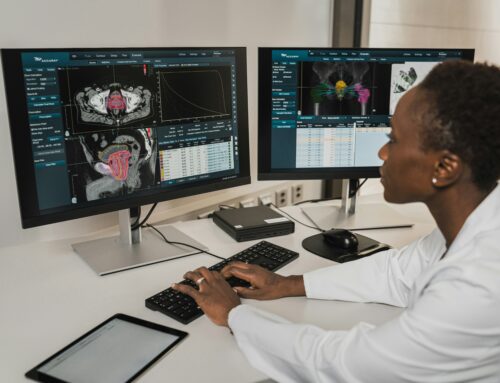Cancer survivors know too well the full meaning of team effort, be it with their team of oncologists, radiotherapists, psychologists or with the care-givers who support their journey when cancer is detected and treatment is necessary. Even so, the road to recovery can be long and endearing. Against this background, research steps that help to deliver better and more efficient care for patients, clinical specialists, and their caregivers – we believe are always welcomed.
The CS_AIW Cluster Better Practice Guide
Within the context of the Cancer Survivorship – AI for Well-being (CS_AIW) Cluster, launched in the FAITH project, the Better Practice Guide (BPG) is one such initiative that exists to help with patient Quality of Life monitoring and to support clinical physicians. The Better Practice Guide initiative, itself, is gathering much attention, not only in the cancer sector but across a wider community, including energy transition and emergency medical services and operational security.
Involving 11 smart technology projects dealing with post-cancer treatment and mental health, the CS_AIW Cluster is a dedicated team. The Cluster takes ownership and working as a unit to deliver a much-needed BPG in the field of eHealth and cancer care specifically. The joint undertaking focuses on patients’ Quality of Life; working towards the development of common datasets, together with a data dictionary for technological communication applicable in post-cancer care. A team from AUTH Medical Physics & Digital Innovation Lab (Greece), Ubitech (Greece), Gradiant Technologies (Spain), as well as Walton Institute and TFC Research and Innovation Limited (Ireland) is guiding the BPG Team. The Clusters’ BPG will be launched in May 2023
The Cluster members have a very close collaboration, clear understanding and are extremely engaged. For as much as possible, the individual project work is shared across the Cluster. Collectively, the member projects benefit from the cross-fertilisation engagement process and the ongoing Cluster activities. Through dialogue and engagement, the Cluster members listen and learn from each other’s experiences. Ultimately, by sharing different perspectives, the projects’ main outputs will better benefit patients and healthcare professionals. Engaging reciprocally, Cluster members’ different perspectives contribute to ensuring that the technical outputs are in line with the needs of the users and will gain their trust.
The Clusters BPG points towards strengthening interoperability capability in post-cancer treatment and survivorship space. In addition, it will support future research project platform interconnectivity. Moreover, the Cluster’s post-cancer model is being built to align with the Fast Healthcare Interoperability Resources (FHIR) specification. The FHIR applies an open Application Programming Interface (API) standard for the exchange of healthcare information. The FHIR standard is defined by Health Level 7 (HL7), the organisation that also defined the HL7 messaging standard.
How the initiative came to be
The Better Practice Guide Initiative was conceived by TFC Research and Innovation Limited, while leading the work on standardisation in the NO-FEAR and supporting standardisation through the development of an Application Programming Interface with the ENCIRCLE project. The former was aimed at establishing a common understanding of the needs and innovation potential of the identified operational gaps in the European Emergency Medical Services sector. The latter focused on improving resilience of CBRN (Chemical, Biological, Radiological and Nuclear) events and threats in Europe and the NO-FEAR is primarily focused on identifying the innovation needs and gap for Emergency Medical Service professionals when a mass casualty situation arises.
Why are Better Practice Guides important?
The Better Practice Guide Initiative primarily sits in the pre-nominative standardisation space. Guides can be developed at low-cost and don’t require direct intervention of national standardisation bodies, etc. These guides are entities in their own right and will be seen and treated that way. Building from the knowledge acquired from the NO-FEAR project and engagement with the ENCIRCLE project, the development of a BPG is driven and empowered by practitioners and operatives, i.e., the Users. The BPG initiative challenges traditional thinking with regards to the pre-nominative standardisation. The mechanism is not driven by standardisation bodies. In fact, it is quite the contrary. Control is empowered to the practitioners and specialists.
Within the CS_AIW, the ‘practitioners’ include cancer survivors, providing them with a chance to be pivotal in their cancer care. Their involvement will strengthen the activities in this space. Indeed, through the design of the Better Practice Guide Initiative, the empowerment process may not necessarily lead to a full standard. It is the authors who decide to escalate to a full standard or stay within the remit and entities of a Better Practice Guide. A more flexible approach helps to meet both practitioner and technological community’s requirements. When preparing a BPG, it is crucial to seek more Users. This allows the delivery of BPGs that work for them. By increasing the number of organisations defining their Better Practice Guide, more common and acceptable approaches will start to emerge. In fact, more real users are taking big inward roads to embrace this route to standardisation.
As indicated, the development of a BPG is not tied to any mechanism promoted by national standardisation authorities. Instead, it is seen as an expression of the following principles: “In practice but not necessarily ordained by law“ and “In practice or actuality, but not officially established“. The independence from national standardisation institutions may be viewed as radical. Nonetheless, it is necessary, as the new initiative is based on the full empowerment of the Users. The BPG initiative provides flexibility for it to work for them. Naturally, this does not rule out standardisation institutions’ involvement at some point, but under the BPG initiative, the drivers are the Users!
Better Practice Guide Initiative Governance
The controlling body of Better Practice Guide aims to promote and generate further interest in the emerging initiative. The BPG Body exercises a coordinating, executive and management function.
The direction for adherence to the imposing seven fundamental principles for the development of a Better Practice Guide document is highlighted as follows:
- Due Process: decisions are made with equity and fairness among participants. No one party dominates or guides BPG development.
- Broad consensus: the process allows for all views to be considered and addressed, such that agreement can be found across a range of interests.
- Transparency: BPG management body provides advance notice to proposed development activities, the scope of work, and conditions for participation. Records of decisions and the materials used in reaching those decisions are easily accessible, and members can provide comments.
- Openness: BPGs are open to interested and informed parties.
- Collective Empowerment: participant collective empowerment works within the realm of providing interoperability, scalability, stability, and resiliency; which serve as building rocks for innovation.
- Availability: BPGs specifications are made accessible to all for implementation, deployment and adoption.
- Voluntary: Used on a voluntary basis, its success is driven by an emerging community.
User-driven Better Practice Guides paving the way to standardisation
The BPG initiative is fresh-thinking. Its approach provides an alternative way of doing things in the pre-standardisation space. However, it is worth repeating that BPGs are entities in their own right. Through the design of the initiative, individual BPGs do not necessarily need to evolve to a full standard.
The BPGs are in the hands of the Users and have the purpose of meeting their needs. Each BPG will be freely available for use and referenced, completely at the discretion of the User. Without the BPG route, it is clear that many organisations may never venture into the development of such documents. The ethos of the BPG initiative, is “in practice or actuality, but not officially established”, is significant and applied at users’ discretion.
In this way, it is predictable that more organisations will take up the Better Practice Guide route. In fact, BPGs have the flexibility to produce a document that works for them, without much rigour and high cost. The newly emerging approach will instigate a process of getting more organisations involved in better practices. Also, BPGs apply to help bridge operational standardisation gaps identified in the field and in EU scientific research projects. Once the current development of the CS_AIW BPG is finalised, the initiative moves to full-blown development, including governance.
With this thinking, we believe that a BPG around cancer care will offer many benefits to users and practitioners. Further details on the Better Practice Guide Initiative will follow over the coming months.
Authors: Tom Flynn, Natasha McCrone (TFC Research and Innovation Limited)




